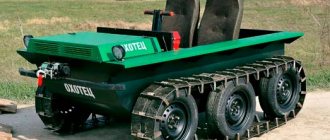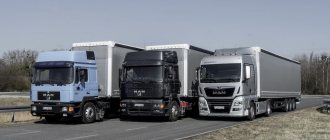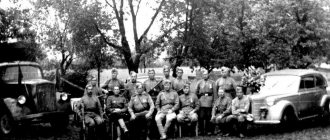During the Soviet Union, great attention was paid to agricultural machinery, because it was the basis for the life of the population. To improve productivity in 1920, Lenin signed a special law on tractor farming and about 2 years later the first models of this equipment appeared, among which were Kolomenets and Zaporozhets. But this was not enough and the first more powerful soviet crawler tractors began to appear after gaining experience abroad. A large tractor production plant was launched in Stalingrad, it became the most powerful in the USSR. We offer you the most complete list of tracked tractors of the USSR.
STZ-3
1937 – 1952
The first serial, more powerful caterpillar tractor, which began to be produced in Stalingrad and Kharkov. Afterwards the Altai plant also got involved, but there they were called ATZ-NATI. More or less, this unit is similar to modern cars: a frame structure, a half-closed cabin and a carburetor engine that develops power up to 52 hp. By the way, the chassis was military. Over the entire period, about 191,000 units were produced.
- Power: 52 hp
- Weight: 5.1 t.
- Speed: 7.9 km/h
DT-54
1949 – 1979
At the start of the 50s, the USSR's tracked tractors were replenished with the first diesel unit, which became one of the most popular. For the development of this technique, the leader and the entire team received a second degree prize, the so-called “Stalin Prize”. Its size was 100 thousand rubles. Over the entire period, almost a million units were built at the Stalingrad, Altai and Kharkov factories.
At that time, the DT 54 crawler tractor was the most powerful and therefore worked on almost every farm or state farm. Its tractive effort could reach 2.85 tons, while the vehicle reached speeds of up to 7.9 km/h. As history says, while driving an agricultural machine, tractor drivers covered 2,000 hectares each, and breakdowns for the machine were not such frequent occurrences. The tractor was successfully exported to other countries; in total, the DT-54 was used by 36 countries; it was most successfully exported to China and Vietnam.
- Weight: 5.4 t
- Length: 3.66 m.
- Height: 2.3 m.
- Width: 1.86 m.
- Track: 1435 mm.
- Power: 54 hp
- Speed: 7.9 km/h
- Tank: 185 l.
[ads-pc-1]
[ads-mob-1]
Steering
The 80 comes with a choice of several steering options:
- hydrovolumetric _ The power pump is a gear pump with a left-hand direction of rotation. The metering pump is gerotor, with an open center, without steering response. The type of rotation mechanism is a double-acting hydraulic cylinder and a steering linkage.
- hydromechanical (installed upon request). The power pump is a gear pump with a left-hand direction of rotation. Type of rotation mechanism - worm, helical sector and hydraulic booster;
- hydrostatic with a metering pump on the hydraulic booster housing (optional on the Tractor-80 tractor with an awning frame or an awning base based on a small cabin). The power pump is a gear pump with a left-hand direction of rotation. The metering pump is gerotor, with an open center, without steering response. The type of rotation mechanism is a double-acting hydraulic cylinder and a steering linkage.
T-75
1960 – 1962
In the 60s, engineers at the Kharkov plant had the idea to modernize the DT 54 tracked tractor , and as a result the T-75 appeared. The version acquired a new engine, which was already able to produce power up to 75 horsepower, a double-disc clutch appeared, and even external differences were noticeable. Over 2 years, the farm received about 45.8 thousand units of equipment. Almost everything was different, including the controls and their location.
- Weight: 5.5 t
- Length: 3.66 m.
- Height: 2.3 m.
- Width: 1.86 m.
- Track: 1435 mm.
- Power: 75 hp
T-74
1962 – 1983
To replace the 75th, the Kharkov plant, which produced the best Soviet tracked tractors , soon introduced a new product for agriculture with improved characteristics. It turned out to be massive; over the entire period, 880,792 units were produced. Externally, it is practically no different from its predecessors. The main engine of the vehicle was the diesel SMD-14A, which developed power up to 75 horsepower. Mechanical 6-speed gearbox and 2 levers for controlling agricultural machinery.
The mass of the caterpillar tractor reached 5.91 tons, the cabin was completely closed and even heated. Here the driver had at his disposal 2 soft seats, a windshield wiper and control levers. All electrical equipment operated at a voltage of 12 V.
- Weight: 5.91 t
- Length: 4.22 m.
- Height: 2.32 m.
- Width: 1.84 m.
- Power: 75 hp
10.5 tons of iron and 60 “horses”: test drive of the S-60 “Stalinets” tractor
Help!
I must brag a little: we have tested almost all of the most popular Soviet tractors.
We wrote about Fordson-Putilovets, and about STZ-15/30, and about Universal-2. So the S-60 is the last most popular pre-war tractor of the USSR. There was also an interesting S-65, but more on that a little later. So: every time we started to remember the history of the tractor, we talked about how it was copied from some American model. They remembered either International Harvester or Ford with his Fordson. Do you think things will change this time? Whatever the case! Now there will be a story of borrowing again. Only more severe: this time the Americans did not just sell a tractor to the Soviet Union, but immediately built a factory. So that for centuries. Tractors "Fordson-Putilovets", "Universal-2", STZ-15/30
1 / 3
Tractors "Fordson-Putilovets", "Universal-2", STZ-15/30
2 / 3
Tractors "Fordson-Putilovets", "Universal-2", STZ-15/30
3 / 3
It would be wrong to think that the entire plant and the S-60 tractor are the fruit of the creativity of American engineers. No, domestic ones also worked well, but at some stage the group of specialists included 40 Americans and only 12 Soviet engineers. I will not talk in detail about the history of ChTZ, but there are definitely some things you need to remember. If only because the S-60 is the first tractor of this plant, and the history of ChTZ dates back to the day the first Stalinets was produced.
So, the decision to build a tractor plant in the Urals was made in 1929. The first sketches for the future plant were made in the USSR, in a design bureau in Leningrad. But designing the entire plant was too long and difficult, so they turned to Albert Kahn and his for help. By that time he had already done projects for the Stalingrad Tractor Plant, in America his company was busy building Ford factories, and in the USSR he later built a lot of good things.
Almost simultaneously with the design of the tractor plant, they began to develop the design of the tractor itself. Here, too, capitalists could not do without: it was easier to take a finished car, rework it thoroughly (or not even thoroughly, the main thing is quickly) and prepare the plant under construction for its production. The very popular Caterpillar 60 at that time was taken as a model for the future Soviet tractor.
The project turned out to be complex: at the same time it was necessary to remake Caterpillar to suit the capabilities and realities of Soviet production, and to work very quickly on the project of the plant itself. It is clear that doing this on opposite sides of the ocean was not very convenient. They decided to invite American specialists to the USSR. But the Yankees, accustomed to comfort, demanded such working and living conditions that the Soviet side brushed them aside. Well, you, they say, are snickering capitalists, in three letters. If you don’t want to come to us, we’ll go to you. And let's go.
The Leningrad design bureau organized a company in Detroit with a very funny name: Chelyabinsk Tractor Plant. As I already said, 40 American and 12 Soviet specialists worked at Chelyabinsk Tractor Plant. It should be noted that the engineers worked hard: in March 1930, this company began work, already at the beginning of June the general plan of ChTZ was ready, and in August of the same year the first workshops were laid. According to the plan, the plant was supposed to produce its first products in 1933.
The question arose: would the new tractor be good enough for mass production? There will be no time to fine-tune it in 1933 - the plan is on fire. What to do? Build a pilot plant. In February 1930, the construction of such a “Chelyabtractorostroy” began, and in February 1931 the first S-60 was built on it. In total, about 20 experimental tractors were produced there, which were tested and fine-tuned.
Meanwhile, ChTZ itself was difficult to build. At first there was a shortage of funds and builders fled. It is clear that the Americans worked only with their heads, but Soviet people worked with wheelbarrows, shovels and crowbars at the construction site. It was hard, but they built it quickly. In 1932, they began to install equipment. To imagine the scale of the plant, I will give a few telling figures: production equipment was supplied from 307 (three hundred seven!) different foreign enterprises (USA, England, France and Germany) and from more than 120 Soviet ones.
But in the end, a smart move with cooperation with the Americans and the construction of a pilot plant worked perfectly: strictly according to plan, the first production S-60 was produced at the plant in May 1933, and the official opening of ChTZ took place on June 1st. By the end of 1933, the plan required the production of 2,000 tractors, but only 1,650 were produced. But by the end of 1934, the 10,000th “Stalinets” had already left the plant.
Now it's time to see what kind of tractor it was. And if you’re lucky, start its engine and go for a ride.
Stop it, I'll get off
We took the tractor on a scow for a test drive. Nobody knew whether it would be possible to start its engine (there had already been unsuccessful attempts). But risk is a noble cause. In addition, there are not so many “Stalinists” on the move. To be more precise, there are two of them. I really wanted the engine to work. There was hope for this, if only because the engine, like the entire tractor, is very simple. But the engine volume is amazing – 18.5 liters! But there are not so many powers: only 60 at 650 rpm.
The engine has four cylinders. They are separate, there is no block, each cylinder (165x216 mm) is screwed to the crankcase separately. The engine compression ratio is 3.96. The lubrication system is combined (splash and pressure from the pump). The camshaft is at the bottom, and pusher rods go from it to the valves in the head. There are eight oil cans in the head into which oil must be periodically added to lubricate the valve guides. The engine consumes not gasoline, but naphtha, and all this modern downsizing is spit on one valve (and there are also eight valves in total).
The cooling system is quite ordinary - with a pump, not a thermosyphon, as it was, for example, in the Universal. And on the pump there are also oil nipples, to which you also sometimes need to add oil.
There is an interesting detail in the ignition system: a magneto provides the spark, and the headlights are powered by a gear-driven generator. By the way, all Stalin vehicles had headlights (they had to plow at night), but its ancestor, the Caterpillar 60, had this as an option.
The motor stands on side members. I don’t specifically say “on the frame spars,” because there are spars, but there are no frames. At the rear, the side members are bolted to the gearbox housing. This entire structure, together with the main gear housing, is a kind of frame.
The gearbox is three-speed, the clutch is dry single-plate. The remaining parts of the transmission are quite typical for similar tracked vehicles: onboard multi-disc clutches, band brakes and final drives. Each caterpillar stands on five support and two support rollers and two guide wheels.
But the controls are interesting. Two pedals equal two brakes (one on each side). We will have to press the clutch with a lever protruding from the floor under our right hand. Gas is also a lever, it is attached to the bracket of the clutch levers. Well, everything is clear with clutches - an ordinary tractor. If you pull the right one, you turn off the drive to the right track and turn right. With the left side everything is exactly the same.
To the left of the driver are two fuel tanks. Large - 390 liters - for naphtha. A small 16-liter tank is the starting tank; gasoline needs to be poured here. We have gasoline, but it’s difficult to find naphtha, so we also have gasoline in a large tank. This tractor doesn't care what it works on.
It’s interesting that the Americans had both “right-handed” versions of their Caterpillars (like ours) and “left-handed ones.” The Stalinists were exclusively “right-handed”. Well, let's try to start the engine? So, where is the starter...
View this post on Instagram
Publication from Kolesa.ru (@kolesaru)
Starting this engine is a task for those strong in both body and spirit. When the power of speech disappeared and the gift of swearing appeared, the engine still started working. He did not work very consistently for us: he shot and sneezed. But it worked. Considering the lack of a muffler and the engine size, the sight is not very pleasant. But we have to go...
It’s good that there is some kind of care for the driver - a soft seat. Okay, okay, I'm kidding: there is no more softness and tenderness there than in the songs of the Sex Pistols. Let's try to move these 10.5 tons of iron from their place.
What can I say... Strength is needed in everything. Engage the gear and pull the clutch lever towards you. And then it starts to shake. Not like on a Honda Accord, but like... I don’t know how to put it into words. Shake like hell. The engine, after all, is also tightly screwed to the side members without any cushions or hydraulic supports, and its volume, as I already said, is more than 18 liters. Everything is shaking. The whole essence of the “Stalinist” screams, shoots and sneezes.
When the engine starts running smoother, it becomes a little easier. But not much. I couldn’t switch to second gear: it’s probably easier to get going from there. First gear is a maximum of 3 km/h, so the concept of acceleration does not exist here. Most likely, skill would come with experience, but well, this experience. I have already learned to enjoy even modern budget carriages with cardboard interiors and foil bodies, but I did not get any pleasure from the C-60. Well, maybe only if it’s aesthetic: a crawling and screaming pile of metal still pleases the eye. But working on it? God forbid. Probably for the first time in my life I was happy about a short test. And as soon as he began to deaf in both ears, he collected all the skeletal bones that had scattered throughout his body into a heap and climbed out of the seat. Enough.
1 / 4
2 / 4
3 / 4
4 / 4
You can blame me: they say, people worked, and you are a weakling. Agree. But every time you ask your wife at home “okay?” I don't want. And if you work on this tractor for a long time, it will be so.
It will probably be even stranger if I say that the tractor is still good. He worked and built, and even fought in the war. At the front he worked as an artillery tractor. And if a German soldier brought a Stalinist as a trophy, he received leave - the S-60 was considered a valuable trophy. Probably for a reason.
Sometimes you can read on the Internet that in 1937 this tractor received the highest award, the Grand Prix, at the exhibition “Art and Technology of Modern Life” in Paris. This is wrong. It was not the S-60, but the S-65 - a later development. Essentially the same tractor, but with an M-17 diesel engine. The S-65 had a slightly different radiator, a different fuel tank location, a slightly different gearbox and differently shaped spars for mounting the engine. The rest is almost the same.
But the fate of the caterpillar bogies was more interesting: they turned out to be so successful that they were later installed on the post-war S-80, and on the T-100, and on the T-130. So parts for them can still be bought today. But I had to tinker with finding other spare parts.
Not here, but there
The skeletons of these tractors can still be found: they were very actively used during the Great Patriotic War, and many of them died. There is almost no interest in restoring tractors, so usually machines found on the fields of former battles ended up as scrap metal. So we managed to find the main part of the tractor, but finding components became a problem. They were collected all over the country.
Of course, some things could be bought in the USA - you can find spare parts for the Caterpillar 60 there. And it would even be quite authentic (in the USSR we also came across “Stalinists” with spare parts from Caterpillars), but I still wanted to assemble the S-60, and not a Soviet-American hodgepodge. But there is an American component in the tractor. More precisely, not one, but four at once - these are spark plugs. On the Stalinets they are the same as on the GAZ-AA lorry, but it is also impossible to find new spark plugs for the lorry. But in the USA they can be found on Ford AA, which is what was done. Otherwise, this is a completely authentic and working S-60. This is, of course, good, but I wouldn’t want to work on it today.
Well, and finally, one observation: I understood why the tractor driver at Stalinets is usually portrayed as grimy. There are a lot of lubrication points and necks in the tractor, where you constantly have to reach with an oil can or a can of oil. No wonder the tractor was constantly dirty. Accordingly, the tractor driver could not remain clean. I’m not sure that this information will be very valuable, but it should add respect to the work of the tractor driver. And especially to the driver of the Stalinist.
DT-75
1963 – 2009
Here is the legendary DT 75 tracked tractor straight from the Soviet Union, which has reached our times. The Volgograd plant was engaged in the production of equipment, and over the entire period about 2,741,000 units were created here, operating even today in some farms of the country. The most popular tractor has naturally been modernized and improved several times to meet modern requirements. At the very start, a diesel engine producing 75 hp was used as the power unit, but then a more powerful version appeared. The latest engine develops 95 horsepower.
Not all Soviet tracked tractors can boast a cabin with two soft seats, which can also be adjusted both by weight and by height. Already in those days they thought about workers and increased the size of the cabin and installed control levers in a more convenient manner. Many people do not know that the DT 75 crawler tractor was also nicknamed the “Postman”. All because of the fuel tank located on the side.
- Weight: 6 t
- Length: 3.48 m.
- Height: 2.65 m.
- Width: 1.89 m.
- Track: 1330 mm.
- Power: 75, 90 and 95 hp.
- Speed: 12 km/h
- Tank: 240 l.
T-150
1973
Universal, included in the most reliable tracked tractors of the USSR and characterized by high performance. The production is carried out by the Kharkov plant, the engine is installed on the front side, the clutch and gearbox are also attached here. Compared to its predecessor, this tractor's engine performance has been greatly increased, power is transmitted in two streams, so the load has noticeably decreased, and all components will work for a long time. The weight of the caterpillar tractor has become noticeably greater compared to previous agricultural machines.
- Weight: 8 t
- Length: 4.32 m.
- Height: 2.89 m.
- Width: 1.85 m.
- Track: 1435 mm.
- Power: 150 hp
- Speed: 31 km/h
Hydraulic suspension system
The hydraulic suspension system was equipped with a hydraulic adhesion weight increaser (GSV), a power and position regulator. The system's load capacity increased from 1500 to 2000 kg by increasing the pressure in the system to 160 kg/cm2 (from 130 kg/cm2). For this purpose, an improved design pump ONSH-32-2 was used. In 1990, the carrying capacity of the hydraulic linkage system of the MTZ-80 tractor was increased to 2500 kg. In addition, a position and force control system was added.
To work with trailed machines, the following were provided: a rigid adjustable towbar, a hydraulic tow hook, a towing device with a shock absorber, an automatic hitch, a pneumatic system, a modified compressor drive (attached to the engine, not to the transmission), additional ballast weights on the rear wheels and on the front semi-frame beam. If necessary, it was possible to install a removable half-track of the MTZ-50 tractor.
DT-175
1986 – 1992
You can complete the answer to the question of what Soviet tracked tractors exist with this model, later named “Volgar”. Traction class 3 was produced at the Volgograd plant and they began to use torque converters in the device, changing the torque from the engine to the gearbox. The equipment was modernized several times, but the basis was the SMD-66 with 6 cylinders and a power of up to 170 horses. such powerful tracked tractors of the USSR for the first time and were amazed at the capabilities of the designers. The machine is controlled using a lever and pedal, there is a ventilation unit in the cabin, there is enough space for two, but there is only one door.
- Weight: 8.03 t
- Length: 5.17 m.
- Height: 2.9 m.
- Width: 1.9 m.
- Power: 170 hp
- Speed: 7.9 km/h
Technical data MTZ-80
MTZ-80 at field work
In the table you can find out detailed data on special equipment provided by the official manufacturer.
| Parameter | Meaning |
| Full name | "Belarus" MTZ-80.1 |
| engine's type | D-240 |
| Vehicle traction class | 1.4T |
| Power parameter (for diesel version) | 59 (80) kW/l. With |
| Total number of gears - forward/reverse | 18/4 |
| Dimensional information (length*height*width) | 3815*2470*1970 mm |
| General track on the front wheels | 1200*1800 mm |
| General track on the rear wheels | 1350*2100 mm |
| Weight of the Belarus MTZ-80 tractor | 3160 kg |
| Design speed range | From 1.3 to 13.5 km/h |
| Agrotechnical clearance | 470 mm |
| Machine turning radius | 4.1 meters |
According to the table, the tractor did not have any special parameters, then why was it so popular?
Engine
The success of the car lies in the design of the engine. Namely, the gearbox mechanism of the MTZ-80 tractor was at that time the most advanced in the history of tractor construction. The diesel engine was marked D-240, which indicated a four-stroke version, with a built-in water cooling principle. The hydraulic system of the MTZ-80 tractor was equipped with a working volume of the cylindrical part of 4.75 liters. The nominal engine speed was 2200 rpm. The internal combustion chamber is of a semi-separate type. The total weight of the engine is no more than 430 kg.
In some models, the gearbox design of the MTZ-80 tractor was improved due to the introduction of a pre-heater of the PZHB-200B series. Based on the operating manual, we can conclude that the special equipment was equipped with two versions of the trigger mechanism for the MTZ-80 tractor transmission circuit: electric starter, and also functioning due to the trigger mechanism of the built-in carburetor device.
Despite the excellent characteristics and design of the front axle of the MTZ-80 tractor, the manufacturer introduced a mandatory point into the technical regulations of the machine, which states that every 60-240-960 operating hours, it is necessary to carry out a technical inspection, according to the developed scheme.
Transmission
An important part of special equipment is the gearbox. If you pay attention to the design of the rear axle of the MTZ-80 tractor, you will notice that the machine has a mechanical and also a 9-speed gearbox with a built-in reduction gearbox. This made it possible to develop a multifunctional speed switching circuit. Moreover, 18 speeds in forward mode and 4 speeds in reverse. By default, the machine is equipped with a creeper, which can be used when performing certain jobs.
In some models produced after 1985, an upgraded engine cooling system of the MTZ-80 tractor with a hydraulically controlled gearbox operating principle was installed. This made it possible to smoothly switch gears during heavy loads of special equipment. A comprehensive cooling system for the MTZ-80 tractor was installed, which made it possible to switch within four speeds. At the same time, the clutch of the MTZ-80 tractor did not disengage while the machine was operating. On the rear axle, the clutch device of the MTZ-80 tractor was equipped with a differential system that was modern at that time. In older models produced before 1985, the differential clutch adjustment of the MTZ-80 tractor was done manually.
Improved MTZ-80
If knocking noises were heard during operation of the machine, this may indicate fatigue of the gears built into the machine unit and the teeth falling out, so it is worth checking the steering diagram of the MTZ-80 tractor.
Brake control
The brake control system of the machine, as well as the steering control of the MTZ-80 tractor, provides the following options:
- Main worker.
- Additional auxiliary.
- Parking brake mechanism.
- Spare brake designs.
Brake control models can be adapted to a specific operation option for the electrical wiring diagram of the MTZ-80 tractor.
Cabin
The driver's cabin has a convenient and comfortable design. The main structure is made of thin sheet steel. The internal part is thermally insulated, all necessary conditions for the operator’s work have been created, including convenient control of the electrical circuit of the MTZ-80 tractor. In the manufacturer's operating instructions, you can familiarize yourself with the data on the power system of the MTZ-80 tractor.
Fuel consumption
An equally interesting point will be information about the fuel consumption of the MTZ-80 tractor. It is interesting that the operating manual indicates only the basic fuel consumption rate of the MTZ-80 tractor, which takes into account the operation of the machine without load - approximately 5 liters per hour. But if we take into account the operating condition under load, then the fuel consumption of the MTZ-80 tractor is approximately 9-13 liters per hour.
MTZ-80 with attachments
For calculation it is recommended to use this working formula:
P=0.7 x R x N, where
P — estimated hourly consumption, kg/hour
0.7 is a conditional coefficient for converting the unit of measurement of the engine power of special equipment known to us from kW. pm.
R – conditional parameter of specific permissible fuel consumption, gkW/hour
N – engine power, hp.











